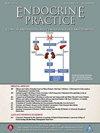多巴胺激动剂治疗对高泌乳素血症患者冲动控制障碍的影响——我们应该如何关注?
IF 3.7
3区 医学
Q2 ENDOCRINOLOGY & METABOLISM
引用次数: 0
摘要
多巴胺激动剂(DAs),包括卡麦角林(CAB)和溴隐亭(BRC),是治疗催乳素瘤的主要药物。与DAs相关的一个未被充分认识的不良影响是冲动控制障碍(ICDs),其特征是强迫行为的发展,包括性欲亢进、病态赌博、暴饮暴食、强迫性购物等,这可能对患者和家庭的生活产生负面影响。本文综述了经DAs治疗的高泌乳素血症患者发生icd的患病率、危险因素、可能的病理生理学、诊断和治疗策略。进行电子文献检索以检索相关文章以纳入本文。在所有研究中,有催乳素瘤或高催乳素血症的DAs患者中icd的发生率从7.5%到46%不等,卡麦角林比溴隐亭更常见。年轻、男性和特定的基因多态性似乎会增加患icd的风险。诊断工具,如明尼苏达冲动性障碍访谈(MIDI)、帕金森氏病冲动性强迫症问卷(QUIP)、Barratt冲动性量表-11 (BIS-11)和基于计算机的测试,都有助于识别icd。建议对患者进行教育和定期筛查,以便尽早发现。发生icd的患者的管理策略可能包括减少DA剂量或停药和精神病学评估。icd可能发生在DAs的高泌乳素血症患者中,如果未被发现,会对他们的生活产生负面影响。需要进一步的研究来充分阐明风险因素和潜在的机制,并确定有效的治疗方法来管理DAs上高泌乳素血症患者的icd。本文章由计算机程序翻译,如有差异,请以英文原文为准。
Impulse Control Disorders in Patients With Hyperprolactinemia on Dopamine Agonist Therapy—How Concerned Should We Be?
Objective
Dopamine agonists (DAs), including cabergoline and bromocriptine, are the mainstay of treatment for prolactinomas. An underappreciated adverse effect associated with DAs is impulse control disorders (ICDs), characterized by the development of compulsive behaviors, including hypersexuality, pathological gambling, binge eating, and compulsive shopping, among others, which can negatively impact patients' and families’ lives. This article reviews the prevalence, risk factors, presumed pathophysiology, and diagnostic and management strategies for ICDs in hyperprolactinemic patients treated with DAs.
Methods
Electronic literature searches were conducted to retrieve pertinent articles for inclusion in this article.
Results
The reported prevalence of ICDs in patients with prolactinomas or hyperprolactinemia on DAs ranges from 7.5% to 46% across studies, with cabergoline being more commonly implicated than bromocriptine. Younger age, male sex, and specific genetic polymorphisms appear to increase the risk of ICDs. Diagnostic tools, such as the Minnesota Impulse Disorders Interview, the Questionnaire for Impulsive-Compulsive Disorders in Parkinson’s Disease, the Barratt Impulsivity Scale-11, and computer-based tests, are instrumental in identifying ICDs. Patient education and periodic screening are advisable for early detection. Management strategies for patients who develop ICDs may include a decrease in DA dose or medication discontinuation, and psychiatric evaluation.
Conclusion
ICDs may occur in patients with hyperprolactinemia on DAs and negatively influence their lives if undetected. Further studies are needed to fully elucidate the risk factors and underlying mechanisms and to identify effective therapies for managing ICDs in patients with hyperprolactinemia on DAs.
求助全文
通过发布文献求助,成功后即可免费获取论文全文。
去求助
来源期刊

Endocrine Practice
ENDOCRINOLOGY & METABOLISM-
CiteScore
7.60
自引率
2.40%
发文量
546
审稿时长
41 days
期刊介绍:
Endocrine Practice (ISSN: 1530-891X), a peer-reviewed journal published twelve times a year, is the official journal of the American Association of Clinical Endocrinologists (AACE). The primary mission of Endocrine Practice is to enhance the health care of patients with endocrine diseases through continuing education of practicing endocrinologists.
 求助内容:
求助内容: 应助结果提醒方式:
应助结果提醒方式:


